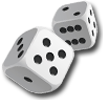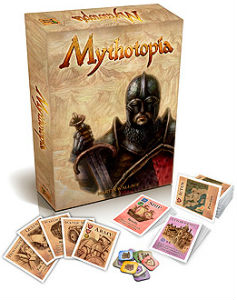



play board games
Board game reviews, strategy tips & session reports
Mythotopia Board Game Review
 Stats:
Stats:
No. of players: 2-4
Amount of time to play: 60-120 min
Age requirements: 13+
Set-up time: 5 min
Mythotopia is a deck-building game mixed with area control and a bit of war game.
Mythotopia Rules Description:
You win Mythotopia by scoring the most VPs. You gain VPs by invading your opponents’ provinces or achieving the victory conditions on Victory Point Cards.
At the start of the game you lay out the three Fixed Victory Point Cards and draw four random Variable Victory Point Cards. Each Victory Point Card has a certain number of VP tokens placed on them. Once four of these cards have no VP tokens remaining the game is near its end. I say near the end, as it is only one of the end game conditions. Ending the game is an action and it must be the first action you take on your turn. You also may only take this action of you are going to win the game.
You start the game with Province cards. These determine your starting locations on the map and may be determined randomly or drafted. You get a different amount depending on the number of players. These are combined with your starting cards to form your starting deck.
On your turn you can take two actions and may even take the same action twice. The actions are invade a province, place armies, remove armies or ships, place ships, end a war, buy armies and ships, draft an improvement card, place cards into your reserve, discard cards remove one or two cards from your deck, patronage, pass or end the game.
To invade a province you must play the card showing the province you are invading from plus one card with a food and any number of cards with army symbols. You place army tokens equal to the total number of these army symbols in your opponent’s province. If you are invading across water you must play ship cards equal to the number of sea spaces you must cross.
Placing armies is mostly the same process but can only be done in a province where you already have army tokens. If the province you are pacing the armies in is not in your control you must still play one card with a food token. But you do not need to play a province card.
When you remove armies or ships, you choose one province or sea space and take as many of those armies or ships back to your ready pile.
Place a ship by playing a card with a ship icon. You may place as many ships as ship icons you play.
The end a war action must be the first action you take on your turn. You can only declare the end of a war when there is a winner. You win a war by having the most military strength. Your military strength in a province equals your umber of tokens plus the number of your ship tokens in an adjacent sea space. If you are the defender you get a bonus for having a citadel there or if you have any terrain bonuses. If you are invading a province that is not controlled by another player it has a military strength of 2 or 3. If the attacker wins he claims the province card of the area he conquered, gains 3 VPs and places one of his town markers there. The defender loses 3 VPs too. If the defender loses nothing changes. No matter who wins all army tokens involved in the war go back to their owner’s ready pile.
Buying armies and ships moves them from your supply to your ready pile. Each army unit costs 1 GP and each ship costs 2 GP. Gold is one of the resources on some of the cards.
Drafting an improvement card may only be done once per turn. It costs 1 GP and goes in your discard pile. Improvement cards are not replenished and grant you special abilities and may have more resource icons on them. Some go in your reserve and others are played from your hand.
You have a reserve to place cards you want to save for a future hand. There can only be two cards in it at the start of the game but you can expand your reserve by building cities and citadels. You can only remove cards from your citadel by playing or discarding them. Cards in your reserve are public.
The discard action lets you discard as many cards as you like from your hand and reserve. But you do not draw back to your hand size until the end of your turn.
If you want to remove a card or two from your deck you place it to the side. This can help you thin your deck but you cannot have less than seven cards in your deck. You can regain cards you have removed from your deck by using the draft one improvement card action.
You can also you an action to just play a card for its action. These cards clearly say action and some are even free actions. They let you end wars, draw cards or a variety of other special actions.
Patronage is a Victory Point card, so this action is only available if it is in play. It gets you VP for paying 2 GP.
Passing is exactly what you think. If you have nothing to do you can pass.
After you take your two actions you retain any un-played cards and draw back up to five cards. This continues until someone can take the End the Game action and win.
Quick Review of Mythotopia:
Mythotopia is a deck-building game mixed with area control. And though it doesn’t do anything brand new it is very engaging and fun. It plays differently with 2 versus 3 or four, but is enjoyable no matter the number of players.
The components for this game are good. The art is fine and the pieces are durable and well made. The rules might need a second reading after your first game (or a short simulated play). Things flow better after you try it.
I was not sure what to think of this game after reading the rules. But once I played it I really liked it. The theme is not particularly strong but the mechanics are.
The variable Victory Point cards add a lot of replay value and can really guide your strategy. When combined with the improvement cards they really create a unique game each time you play.
After a play or two I suggest using the starting card draft rules. This lets you hone your strategy and starting position from the start of the game.
Be warned the endgame can be drag with three or more players. Since you must use an action to win the game players will gang up on leader. This really bothers some groups so it is something to keep in mind. The two-player game is more of a tug-of-war and doesn’t suffer from this.
It can be hard to catch up if you fall behind early or don’t build for the long haul. So players that know what the improvement cards do and which work best in a given situation and likely to beat players without that knowledge.
Mythotopia is one of the better games I have played this year. I was surprised how much fun it was. If you like deckbuilders you should try it out. I think most groups will enjoy this game unless they dislike the end game table talk to stop the current leader from winning.
Score and synopsis: (Click here for an explanation of these review categories.)
Strategy 5 out of 6
Luck 4 out of 6
Player Interaction 5 out of 6
Replay Value 5 out of 6
Complexity 5 out of 6
Fun 5 out of 6
Overall 5 out of 6

Leave a Reply